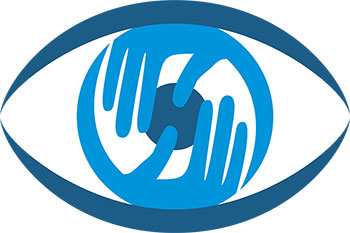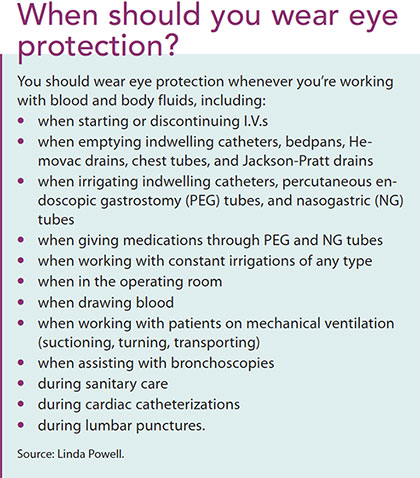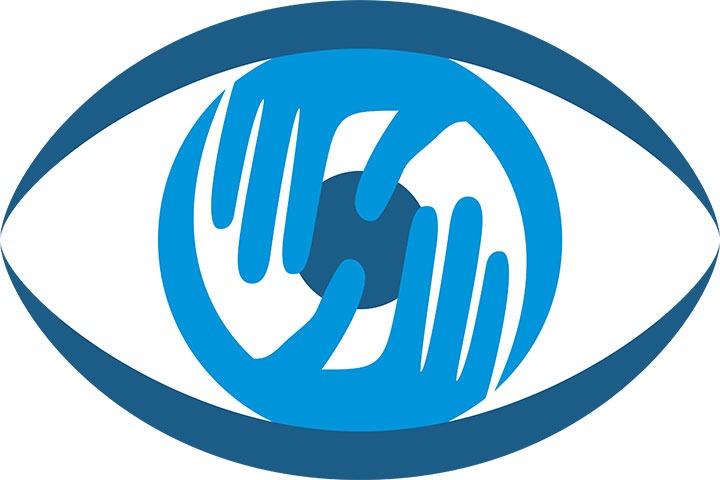Authors: Amber Hogan Mitchell, DrPH, MPH, CPH and Linda Powell, MSN, RN, FNP
Take the time to protect your eyes from pathogens.
Takeaways:
- Nurses sustain the largest percentage of blood and body fluid exposures (BBFE) in acute-care settings in the United States.
- From 50% to 60% of splashes that touch unprotected skin are blood or body fluids visibly contaminated with blood; 83.4% occur to the nurse’s face and 66.7% occur to their eyes.
- Of those nurses reporting any kind of BBFE, only 8.1% said they were wearing eye protection.
- Eye protection should be used whenever exposure to body fluids or infectious viruses and bacteria can occur, not just when exposure is likely to occur.
By Amber Hogan Mitchell, DrPH, MPH, CPH and Linda Powell, MSN, RN, FNP
Editor’s note: March is Workplace Eye Wellness Month. In this first of a two-part series on protecting your eyes from splashed body fluids that may contain pathogens, we share insights from two experts: Amber Hogan Mitchell, DrPH, MPH, CPH, president and executive director of the International Safety Center; and Linda Powell, MSN, RN, FNP, workers’ compensation case manager for Scripps Green/Scripps Encinitas in California.
How many nurses are exposed to splashes at work?
Mitchell: Nurses sustain the largest percentage of blood and body fluid exposures (BBFEs) in acute care settings in the United States. According to the International Safety Center’s Exposure Prevention Information Network (EPINet®) national surveillance data from 2012 to 2016, nurses experience a disproportionate number of all splashes and splatters—about 50% (range of 47.7% to 54%) compared to all other healthcare professionals. Almost 60% occur in patient or exam rooms, and about 25% occur evenly distributed between emergency departments and operating rooms. Nurses report that 62.8% of all splashes touch unprotected skin.
From 50% to 60% of those exposures are blood or body fluids visibly contaminated with blood. An unacceptable number of these incidents occur to the nurse’s face (83.4%); of those, 66.7% occur to their eyes.
Although we hear less about splashes than needlestick injuries, nurses experience slightly more splashes at the bedside in patient or exam rooms (the primary settings for needlesticks as well as splashes).
What are the dangers of splashes to the eyes?

Mitchell: Splashes to the eyes can result in transmission of bloodborne pathogens, bacteria, multidrug-resistant organisms, and other microorganisms. Dozens of pathogens, including HIV, hepatitis C virus (HCV), influenza, severe acute respiratory syndrome, herpes B virus, plague, rabies, and Ebola, have been documented to be transmitted via eye exposures. Few facilities do active surveillance for employees, so we can’t estimate how many eye and mucus membrane exposures result in colonization or infection with multidrug-resistant organisms—and how many of these may result in cross-contamination or transmission to patients, coworkers, or family members.
One might argue that eye exposures are the riskiest exposure types, potentially resulting in not just pain and injury, but also infection or illness.
Powell: Eye splashes can have damage beyond blood-borne pathogen exposures. The pH of medications and body fluids can cause corneal trauma and corneal ulceration, resulting in the loss of use of one or both eyes. Viruses and bacteria—including adenovirus, herpes simplex, Staphylococcus aureus, and rhinoviruses—can be spread to the ocular mucus membrane by splashes, coughing, or touching the area with a contaminated hand or finger.
Do most nurses wear eye protection?
Mitchell: Unfortunately, no. Of those nurses reporting any kind of BBFE, only 8.1% said they were wearing eye protection. The percentage is even lower for exposures specific to the eyes: In 2016, only 1.7% reported they were wearing eye protection when the BBFE occurred, compared to 2012, when 7.3% said they were. Interestingly, in 2016, 62.8% reported BBFEs occurred in a patient or exam room, compared to 2012, when 44% were reported in the same location. This may mean that nurses are experiencing more exposures at the bedside and were wearing eye personal protective equipment (PPE) less frequently.
This trend has to be reversed and exposures must be reported and recorded so that they can be addressed and prevented. Organizations should consider incorporating eye and face protection not just into their infection prevention and control caddies, but also as a permanent fixture in patient rooms (either door or wall mounted).
What are the costs of splashes to the organization?
Mitchell: BBFEs are serious business and can have a negative effect on an organization. The effect may be disproportionate in smaller facilities compared to larger ones because a single exposure in a small practice can result in not only disruption of patient care, but also compromised staffing, time away from work, employee turnover, and financial impact. In larger facilities, the organizational impact is different but also substantial (disruption of patient care, an immediate need to shuffle staffing, and costs associated with patient/source and employee baseline testing, postexposure follow-up, and potential prophylaxis).
Cost can range from $800 to $6,000 for a single exposure to $80,000 to $1,000,000 or more if an employee seroconverts to a bloodborne disease such as HCV and needs lifetime treatment. Additional costs can be accrued through workers’ compensation insurance costs and premiums, not to mention potential Occupational Safety and Health Administration (OSHA) fines if an inspection occurs as a result of an employee complaint.
But the greatest expense is emotional. Because of the underlying stigma associated with occupational BBFE and reporting it, employees may not receive the medical care they need after an incident, which may increase their likelihood of becoming ill or seroconverting.
What are the standards regarding eyewear protection?
Mitchell: Although standards from the government and professional associations state the need for eye protection, they’re not sufficiently healthcare focused.
The OSHA PPE Standard (29 CFR 1910.132) includes requirements for eye protection but is focused on physical hazards that may cause injury rather than illness or infection. OSHA’s Bloodborne Pathogens Standard (29 CFR 1910.1030) leaves selection and placement of eye protection up to the employer, based on its exposure assessment. The standard states, “When there is occupational exposure, the employer shall provide, at no cost to the employee, appropriate personal protective equipment such as, but not limited to, gloves, gowns…eye protection [italics added]….” This is why tracking exposures is important, so that the circumstances surrounding them can be documented and appropriate PPE made available to employees.
The National Institute for Occupational Safety and Health states that “eye protection chosen for specific work situations depends upon the nature and extent of the hazard, the circumstances of exposure, other protective equipment used, and personal vision needs.” The Association of periOperative Registered Nurses’ standards on surgical attire include eye protection, and the American Optometric Association website provides guidance for workplace eye safety.
The lack of standard requirements for nurses’ eye protection and the high prevalence of eye exposures compared to all other exposure types make it clear that we have work to do to convince policy makers, legislators, regulators, professional associations, and advocacy groups that we need to create or amend standards to protect nurses.
Powell: The Centers for Disease Control and Prevention recommends eye protection whenever staff may be at risk for acquiring infectious diseases through exposure to the ocular membrane.
 When should nurses wear eye protection?
When should nurses wear eye protection?
Powell: Eye protection should be used whenever exposure to body fluids or infectious viruses and bacteria can occur, not just when exposure is likely to occur. The rule of thumb is that if you put on gloves, put on eye protection.
Why don’t nurses wear eye protection?
Powell: The two main reasons are lack of availability and failure to establish a habit of wearing it. Eye protection needs to be available at the point of service. If staff have to go outside of the patient room to obtain protection, odds are they won’t do it. To encourage the habit of wearing eye protection, managers must set expectations and provide ongoing education about its importance.
In the second part of this series, Mitchell and Powell will focus on how organizations—and nurses—can reduce injuries from eye splashes.
This series is supported by an unrestricted educational grant from Tidi Products.
[pdf-embedder url=”https://www.myamericannurse.com/wp-content/uploads/2018/03/ant3-Splash-208.pdf”]
